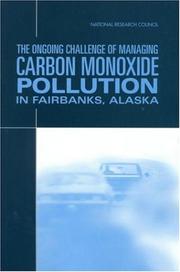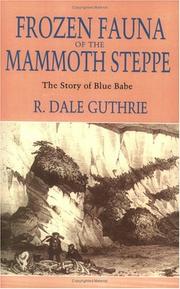| Listing 1 - 4 of 4 |
Sort by
|
Book
ISBN: 1602231109 9781602231108 9781602230644 1602230641 Year: 2009 Publisher: Fairbanks University of Alaska Press
Abstract | Keywords | Export | Availability | Bookmark
 Loading...
Loading...Choose an application
- Reference Manager
- EndNote
- RefWorks (Direct export to RefWorks)
Alaska has always attracted people from varied backgrounds. In A Place of Belonging, Phyllis Movius introduces us to five women who settled in Fairbanks between 1903 and 1923 and who typify the disparate population that has long enriched Alaska. The women's daily lives and personal stories are woven together in these biographical portraits, drawn from the women's letters, memoirs, personal papers, club records, their own oral histories and published writings. Enriched by many never-before-published historical photos, Movius's research gives us a unique inroad into life on the frontier.
Women pioneers --- Women --- Social life and customs --- Fairbanks (Alaska) --- History

ISBN: 0309084849 9786610183449 1280183446 0309566177 9780309566179 9780309084840 0309182751 Year: 2002 Publisher: Washington, D.C. National Academy Press
Abstract | Keywords | Export | Availability | Bookmark
 Loading...
Loading...Choose an application
- Reference Manager
- EndNote
- RefWorks (Direct export to RefWorks)
Air -- Pollution -- Research -- Alaska -- Fairbanks. --- Air quality -- Standards -- Alaska -- Fairbanks. --- Carbon monoxide -- Toxicology -- Research -- Alaska -- Fairbanks. --- Electronic books. -- local. --- Fairbanks (Alaska). --- Particles -- Health aspects -- Research. --- Carbon monoxide --- Air --- Air quality --- Particles --- Environmental Pollution --- Public Health --- Environment and Public Health --- Health Care --- Air Pollution --- Environmental Exposure --- Civil & Environmental Engineering --- Engineering & Applied Sciences --- Environmental Engineering --- Environmental aspects --- Pollution --- Standards --- Research --- Health aspects --- Toxicology --- Research. --- Fairbanks (Alaska) --- Size of particles --- Quality of air --- Carbonic oxide --- Quality --- Fairbanks, Alaska --- Feyrbanks (Alaska) --- Феърбанкс (Alaska) --- Feŭrbanks (Alaska) --- Фэрбенкс (Alaska) --- Fėrbenks (Alaska) --- Фербенкс (Alaska) --- フェアバンクス (Alaska) --- Feabankusu (Alaska) --- Фэрбанкс (Alaska) --- Fėrbanks (Alaska) --- Фербанкс (Alaska) --- 費爾班克斯 (Alaska) --- Fei er ban ke si (Alaska) --- Feierbankesi (Alaska) --- Clay --- Colloids --- Sand --- Soils --- Environmental quality --- Atmosphere --- Gases, Asphyxiating and poisonous --- Grammar, Comparative and general Particles --- Grammar, Comparative and general --- Function words
Book
ISBN: 1883309077 9781883309077 9781883309060 1883309069 Year: 2010 Publisher: Fairbanks, Alaska University of Alaska Foundation
Abstract | Keywords | Export | Availability | Bookmark
 Loading...
Loading...Choose an application
- Reference Manager
- EndNote
- RefWorks (Direct export to RefWorks)
When Alaskans in the 1950s demanded an end to ""second-class citizenship"" of territorial status, southern powerbrokers on Capitol Hill were the primary obstacles. They feared a forty-ninth state would tip the balance of power against segregation, and therefore keeping Alaska out of the Union was simply another means of keeping black children out of white schools. C.W. ""Bill"" Snedden, the publisher of America's farthest north daily newspaper, the Fairbanks Daily News-Miner, helped lead the battle of the Far North against the Deep South. Working behind the scenes with his protege, a young atto.
Statehood (American politics) --- Newspaper editors --- Editors --- Journalists --- Snedden, Charles Willis, --- Snedden, C. W. --- Snedden, Bill, --- Fairbanks daily news-miner --- History. --- Alaska --- Politics and government

ISBN: 022615971X 9780226159713 0226311228 9780226311227 0226311236 9780226311234 Year: 1990 Publisher: Chicago
Abstract | Keywords | Export | Availability | Bookmark
 Loading...
Loading...Choose an application
- Reference Manager
- EndNote
- RefWorks (Direct export to RefWorks)
Frozen mammals of the Ice Age, preserved for millennia in the tundra, have been a source of fascination and mystery since their first discovery over two centuries ago. These mummies, their ecology, and their preservation are the subject of this compelling book by paleontologist Dale Guthrie. The 1979 find of a frozen, extinct steppe bison in an Alaskan gold mine allowed him to undertake the first scientific excavation of an Ice Age mummy in North America and to test theories about these enigmatic frozen fauna. The 36,000-year-old bison mummy, coated with blue mineral crystals, was dubbed "Blue Babe." Guthrie conveys the excitement of its excavation and shows how he made use of evidence from living animals, other Pleistocene mummies, Paleolithic art, and geological data. With photographs and scores of detailed drawings, he takes the reader through the excavation and subsequent detective work, analyzing the animal's carcass and its surroundings, the circumstances of its death, its appearance in life, the landscape it inhabited, and the processes of preservation by freezing. His examination shows that Blue Babe died in early winter, falling prey to lions that inhabited the Arctic during the Pleistocene era. Guthrie uses information gleaned from his study of Blue Babe to provide a broad picture of bison evolutionary history and ecology, including speculations on the interactions of bison and Ice Age peoples. His description of the Mammoth Steppe as a cold, dry, grassy plain is based on an entirely new way of reading the fossil record.
Blue Babe (Steppe bison). --- Paleobiology. --- Paleontology -- Alaska -- Fairbanks Region. --- Steppe bison --Alaska -- Fairbanks Region. --- Steppe bison --- Blue Babe (Steppe bison) --- Paleontology --- Paleobiology --- Geology --- Earth & Environmental Sciences --- Paleozoology --- Palaeobiology --- Biology --- Fossilogy --- Fossilology --- Palaeontology --- Paleontology, Zoological --- Historical geology --- Zoology --- Fossils --- Prehistoric animals in motion pictures --- Mummified animals --- Bison priscus --- Bos priscus --- Bison, Fossil --- mammals, fossils, ice age, preservation, bison, mummy, blue babe, excavation, science, research, pleistocene, paleolithic art, geology, carcass, death, freezing, extinction, evolution, history, ecology, mammoth steppe, plain, alaska, fairbanks, paleontology, ethology, nonfiction, phylogeny, hunting, animal human relationships, tundra, wild horses, lions, bushland, grazing.
| Listing 1 - 4 of 4 |
Sort by
|

 Search
Search Feedback
Feedback About UniCat
About UniCat  Help
Help News
News